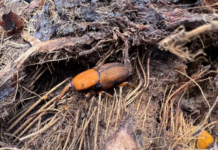
Greenhouse gas emissions represent a significant global concern, driving climate change on a massive scale. This concern is particularly pronounced in rainfed agriculture, where understanding and addressing these emissions are crucial for ensuring sustainable agricultural practices.
In South Africa, rainfed agriculture is vital in food production, contributing substantially to the nation’s agricultural output. However, this sector also stands as a notable contributor to greenhouse gas emissions, primarily through activities such as livestock farming, fertiliser use, and changes in land use.
Dr Jerry Dlamini, a distinguished lecturer and researcher specialising in agronomy within the Department of Soil, Crop, and Climate Sciences at the University of the Free State (UFS), is leading pioneering research in this field. His current project, @CROPGas on X, funded by the European Joint Programme (EPJ), with a budget of R22 million, focuses on investigating the impact of various conservation agriculture interventions on greenhouse gas emissions, primarily targeting nitrous oxide (N2O), methane (CH4), and carbon dioxide (CO2).
This two-year project, which commenced in December 2022 and concludes in December 2024, is a collaborative effort between European and African universities and institutions, including Rothamsted Research (UK), University College Dublin (Ireland), University of Nottingham (UK), University of Poznan (Poland), British Geological Surveys (BGS), University of Zambia (Zambia), University of Zimbabwe, and Lilongwe University of Agriculture and Natural Resources (Malawi).
Dr Dlamini’s preliminary findings from the UFS Kenilworth Experimental Farm indicate that climate-smart agriculture interventions, such as legume rotation and no-till practices, have the potential to reduce the intensity of greenhouse gas emissions, particularly highly radiative gases like N2O.
“This is a significant finding,” Dr Dlamini noted, “as N2O has a global warming potential 100 times greater than CO2 over a 100-year horizon, meaning its impact on ozone depletion persists far longer despite being emitted in smaller quantities.”
Looking ahead, Dr Dlamini advocates for increased research efforts to quantify greenhouse gas emissions from South African croplands. He emphasises the importance of field-based measurements, akin to methodologies employed by other nations, to enhance the accuracy and effectiveness of South Africa’s greenhouse gas inventories submitted annually to the United Nations Framework Convention on Climate Change (UNFCCC) and to devise effective mitigation strategies.







